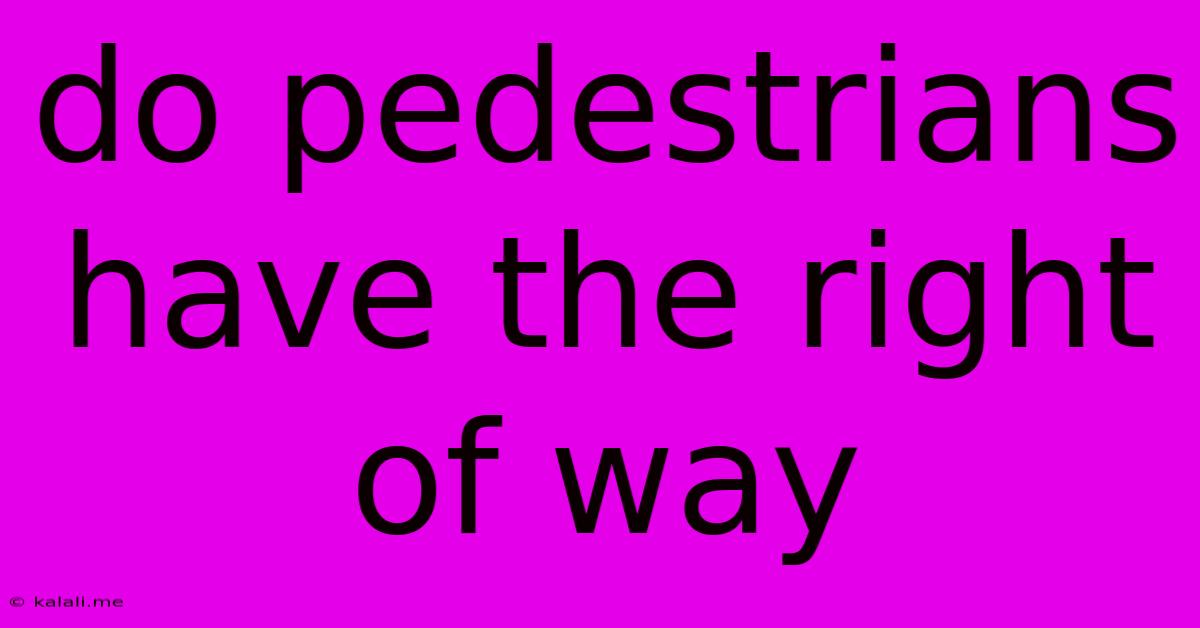Do Pedestrians Have The Right Of Way
Kalali
May 25, 2025 · 3 min read

Table of Contents
Do Pedestrians Have the Right of Way? A Comprehensive Guide
Meta Description: Understanding pedestrian right of way laws is crucial for both drivers and walkers. This article clarifies who has the right of way in various situations, explores exceptions, and offers tips for safe pedestrian and driver behavior.
Navigating streets and roads safely requires understanding the rules of the road, especially concerning pedestrian right of way. While the general principle is that pedestrians have the right of way, the specifics are nuanced and vary slightly depending on location and specific circumstances. This comprehensive guide will clarify the intricacies of pedestrian right of way laws, helping both drivers and pedestrians understand their responsibilities and rights.
What Does "Right of Way" Mean for Pedestrians?
"Right of way" essentially means the legal precedence to proceed first. For pedestrians, this translates to drivers being legally obligated to yield to them in designated areas and under specific conditions. This doesn't mean pedestrians can act recklessly; it means drivers must exercise caution and prioritize pedestrian safety. Failure to yield can result in significant legal consequences for drivers, ranging from fines to more serious penalties in cases of accidents.
Where Do Pedestrians Typically Have the Right of Way?
Pedestrians generally have the right of way in the following situations:
- Crosswalks: This is the most common scenario. Drivers must stop and yield to pedestrians already in or entering a crosswalk. This applies to marked crosswalks as well as unmarked crosswalks at intersections.
- Intersections: At intersections with no traffic signals or signs, pedestrians typically have the right of way when they have already entered the crosswalk. However, this is often dependent on the specific traffic laws of the area.
- Designated Pedestrian Areas: Areas specifically designated for pedestrians, such as pedestrian-only zones or walkways, naturally grant pedestrians priority.
- Entering or Exiting Vehicles: Pedestrians exiting or entering vehicles usually have the right of way, although drivers need to remain vigilant to avoid accidents.
Exceptions and Considerations
While pedestrians generally have the right of way in the situations listed above, some exceptions and important considerations exist:
- Traffic Signals: Pedestrians must obey traffic signals. A "Don't Walk" signal indicates that pedestrians should not enter the crosswalk.
- Blind Spots: Pedestrians should be aware of drivers' blind spots and take necessary precautions. Making eye contact with drivers can help ensure they see you.
- Speed and Visibility: Weather conditions (rain, snow, fog) and low light can significantly reduce visibility for both pedestrians and drivers. Extra caution is necessary in such conditions.
- Specific Local Laws: Traffic laws vary between jurisdictions. Familiarize yourself with local pedestrian laws in your area.
- Specific Road Markings: Check for any specific road markings or signage providing directions to pedestrians.
Safe Practices for Pedestrians and Drivers
Both pedestrians and drivers share the responsibility of ensuring safe street navigation:
For Pedestrians:
- Make Eye Contact: Try to make eye contact with drivers before crossing the street.
- Use Crosswalks: Always use crosswalks whenever possible.
- Be Visible: Wear bright clothing, especially at night or in low-visibility conditions.
- Put Away Distractions: Avoid using your phone or engaging in other distracting activities while walking.
- Be Aware of Surroundings: Pay attention to traffic, and be cautious of blind spots.
For Drivers:
- Yield to Pedestrians: Always yield to pedestrians in crosswalks and at intersections.
- Reduce Speed: Reduce your speed, especially in areas with high pedestrian traffic.
- Be Aware of Surroundings: Look out for pedestrians, particularly children and the elderly.
- Check Blind Spots: Before proceeding, check your blind spots to avoid accidents.
- Obey Traffic Signals: Adhere to all traffic signals and signs.
Understanding pedestrian right of way is essential for creating safe and efficient roadways. By following these guidelines and prioritizing safety, both pedestrians and drivers can contribute to a safer environment for everyone. Remember to always be aware of your surroundings and exercise caution to prevent accidents.
Latest Posts
Latest Posts
-
Why Does My Cat Suck On My Blanket
May 25, 2025
-
Are Front Rotors The Same As Back Rotors
May 25, 2025
-
Arithmetic Overflow Error Converting Expression To Data Type Int
May 25, 2025
-
Adding A Carport To A Garage
May 25, 2025
-
What Do You Call Someone Who
May 25, 2025
Related Post
Thank you for visiting our website which covers about Do Pedestrians Have The Right Of Way . We hope the information provided has been useful to you. Feel free to contact us if you have any questions or need further assistance. See you next time and don't miss to bookmark.